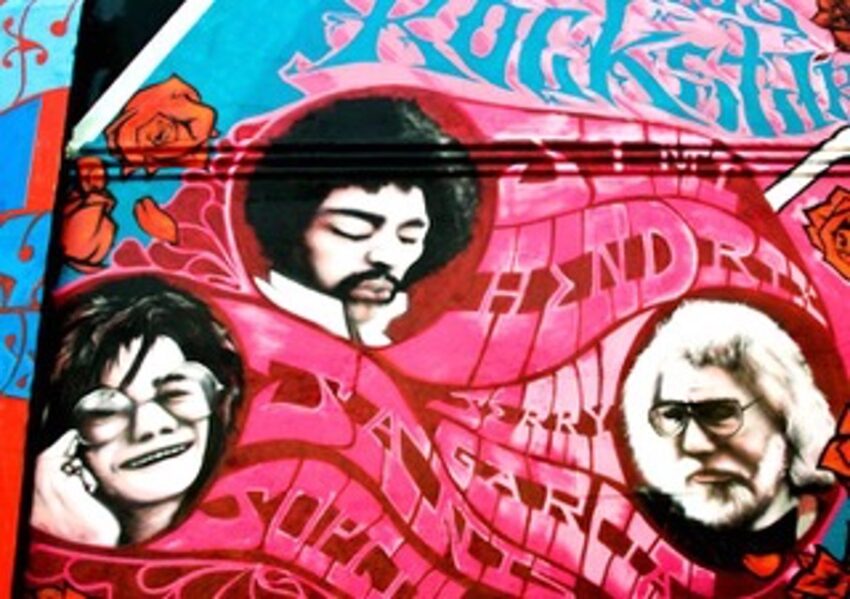By Cory Franklin
August 1st, 2025
Do drugs make musicians more creative?
The United States and Great Britain in the 1960s and 70s were a golden age for creative musicians who pioneered a number of original musical genres that thrive today in one form or another. Recently, two of the greatest figures of that era died within days of each other: Brian Wilson, who popularized surf music and took rock in previously unexplored directions, and Sly Stone, one of the first to fuse rock with funk and soul music.
The two had much in common despite outward differences, including, unfortunately, being victims of serious drug abuse. Musicians constantly seek their muse, but the pernicious trend of abusing drugs has ended or devastated the lives of artists such as those of Wilson and Stone, depriving the world of many of their gifts.
The careers of Brian Wilson and Sly Stone, born less than a year apart, resembled each other in a number of ways. Brian Wilson was a White kid from the car and surfer culture of Southern California in the early 1960s, when there was a mass national migration to the region. Wilson had a preternatural ear for music and though never a surfer himself, adopted the music of that culture and turned it into an international phenomenon.
But his genius lay in developing this music into some much deeper – a rich, complex, and unique musical style that left everyone from Leonard Bernstein to Paul McCartney in awe. The meteoric rise of the Beach Boys, the group he founded, lasted essentially only five years from 1962 to 1966, when his life unraveled, beset by family and business pressures, bouts of mental illness, and notably, extensive drug use that included ample amounts of LSD. After that, he drifted musically and was never the same. While he did perform and compose sporadically after that, occasionally with well-received work, the truth is that his later music would have been ignored but for the genius of his early career.
His 1966 masterpiece, Good Vibrations, is often recognized as drug-enhanced, but ultimately those same drugs that helped produce it soon destroyed his creativity. He acknowledged in a 2016 Rolling Stone interview, “I want people to realize that drugs can be very detrimental and dangerous. I’ve told a lot of people don’t take psychedelic drugs. It’s mentally dangerous to take. I regret having taken LSD. It’s a bad drug.”
Sly Stone, a Black kid from Northern California, grew up as a self-taught musical child prodigy who learned to play at least four instruments as a boy. He made his name as a producer and performer in the Bay Area of the late 1960s, when youth were flocking to San Francisco with flowers in their hair. Amidst race riots and the Vietnam War, the Beach Boys were by then considered passe and square.
Like Brian Wilson, Sly created a new style of music, in his case based on a racial fusion blend of rhythm and blues, funk and soul. His band, Sly and the Family Stone, gave a legendary performance at the 1969 Woodstock Festival, a highlight of the movie “Woodstock.” This propelled Sly to the top of the pop and soul charts.
His music profoundly influenced later Motown recordings and artists from Prince and Rick James to Public Enemy and LL Cool J.
But as a result of copious drug use, Sly’s career, like that of Brian Wilson, quickly melted down after roughly five years, 1967 to 1971. His musical gift squandered, his performances became more erratic, and he became a frequent no-show at concerts. In Chicago, his tardiness to a show resulted in the notorious 1970 Grant Park riot that turned violent and saw nearly 100 people injured. Also, like Wilson, Sly’s business difficulties and issues with bandmates followed predictably. His drug use became so bad that for a time he was homeless and lived in a camper in Los Angeles.
The story of how drugs destroyed brilliant musicians is a recurrent theme. It had happened before in the 1940s and 50s with the scourge of a heroin endemic in the jazz world. Jazz greats including Miles Davis, Charlie Parker, John Coltrane, Bill Evans, Chet Baker, Stan Getz, as well as celebrated jazz singers Billie Holiday and Anita O’Day, developed habits which damaged or truncated their careers. In many cases, the artists abused alcohol, either in combination with heroin or in an attempt to wean from heroin, with subsequent harm to their music, often resulting in the artists’ premature death. Imagine how much more great jazz there could have been.
Some life lessons are hard-earned, if at all. It is somewhat surprising that Brian Wilson and Sly Stone survived into their eighties – even though they died artistically in their twenties. Others contemporary musicians were not as lucky: Janis Joplin, Jimi Hendrix, Brian Jones and Amy Winehouse (died in their twenties), Keith Moon and John Bonham (their thirties), Elvis Presley and Whitney Houston (their forties), Michael Jackson, Jerry Garcia and Prince (their fifties), and Tom Petty (his sixties).
The tale of Faust is the story of a man who sells his soul to the devil in order to gain knowledge and perform magical deeds but who cannot avoid eventually being consumed. For a fortunate few, perhaps like Keith Richards or Ozzy Osbourne (although, in truth, Ozzy was more a performer than a bona fide musical talent), drugs enhance their music briefly, but in virtually every case drugs ultimately erode and then destroy the creative impulse. Despite their musical brilliance, Brian Wilson and Sly Stone, between them, left little more than a decade’s worth of wonderful music before their lives turned tragic and unproductive. They took drugs and eventually drugs took them.
-30-

Dr. Cory Franklin
Cory Franklin, physician and writer, is a frequent contributor to johnkassnews.com. Director of Medical Intensive Care at Cook County (Illinois) Hospital for 25 years, before retiring he wrote over 80 medical articles, chapters, abstracts, and correspondences in books and professional journals, including the New England Journal of Medicine and JAMA. In 1999, he was awarded the Shubin-Weil Award, one of only fifty people ever honored as a national role model for the practice and teaching of intensive care medicine.
Since retirement, Dr. Franklin has been a contributor to the Chicago Tribune op-ed page. His work has been published in the New York Times, New York Post, Washington Post, Chicago Sun-Times and excerpted in the New York Review of Books. Internationally, his work has appeared internationally in Spiked, The Guardian and The Jerusalem Post. For nine years he hosted a weekly audio podcast, Rememberingthepassed, which discusses the obituaries of notable people who have died recently. His 2015 book “Cook County ICU: 30 Years Of Unforgettable Patients and Odd Cases” was a medical history best-seller. In 2024, he co-authored The COVID Diaries: Anatomy of a Contagion As it Happened.
In 1993, he worked as a technical advisor to Harrison Ford and was a role model for the physician character Ford played in the film, The Fugitive.
The post The Faustian Bargain of Rock and Roll appeared first on John Kass.
Click this link for the original source of this article.
Author: johnkass
This content is courtesy of, and owned and copyrighted by, https://johnkassnews.com and its author. This content is made available by use of the public RSS feed offered by the host site and is used for educational purposes only. If you are the author or represent the host site and would like this content removed now and in the future, please contact USSANews.com using the email address in the Contact page found in the website menu.








